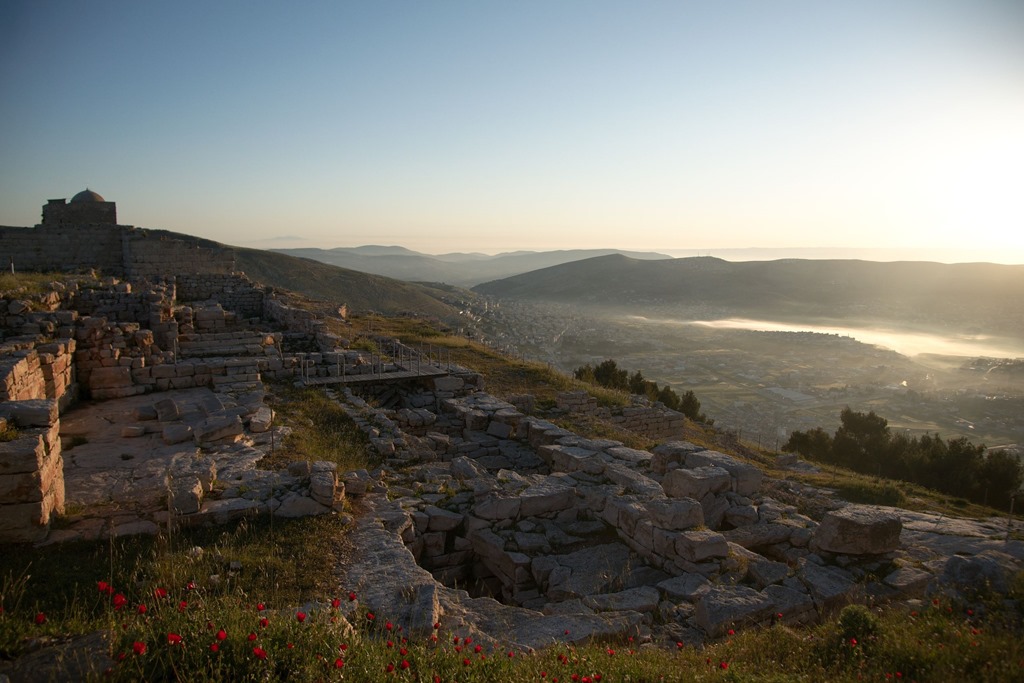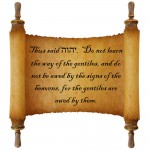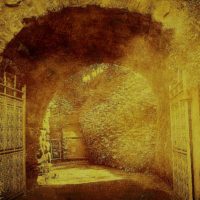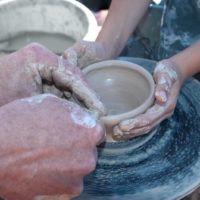In my previous article on how to do Bible study; I emphasized the importance of context a number of times. Recently, I saw this importance again when I was doing some Bible study with my own children.
We have recently finished our study of the books of the prophets and the post-exilic period. We planned to follow this up with a study of the life of Y’Shua and the book of Acts. My wife and I decided that it would be a good idea to give the children some historical and cultural context, by first spending some time on the inter-testamental period. We wanted to ensure that the children had a decent understanding of the changes that had happened in the world between the books of Malachi and Matthew.
The purpose of this study was not to be a history lesson, but purely to show them how the people of Jerusalem went from a small group of people led by a High-Priest and Governor, serving under the Persians, to a mighty nation led by the High-Priest, Pharisees, Sadducees and scribes under Roman rule.
While studying the Persian period after Nehemiah and Ezra, I stumbled across a part in the book of Josephus that described the building of the temple on Mount Gerizim. This small bit of information led me to a more complete study on the Samaritans. Once I had done this, I suddenly had a lot more insights into two incidents in the Apostolic Scriptures. I have decided to write up this study as an example of how the context could lead us to a more complete understanding of the text.
We will first look at the basic history that led to the formation of the Samaritans, then look at the relationship between the Judeans and Samaritans before we look at the insight this provides us.
The History of the Samaritans
The story of the Samaritans started with the exile of Israel, the ten northern tribes, by the Assyrians. It was the strategy of the Assyrians not to remove all the people from the land that they conquered. They rather followed a strategy of assimilation to mix the nations they had conquered into a “new†nation. We see that once Israel had been conquered, the Assyrians relocated some of the people of the ten tribes and replaced them with people from other nations they had conquered. We read about the people who were sent to Samaria in the second book of Kings. However, the lions came and killed the people now living in Samaria. The conclusion was made that  the god of the land was unhappy about the way the people were worshiping him. Thus, the solution was to send some of the priests back to teach the people how to worship YHVH. Of course, they did not give up all their own gods, but simply mixed the religions.
2 Kings 17:22–29
22 The sons of Israel walked in all the sins of Jeroboam which he did; they did not depart from them 23 until YHVH removed Israel from His sight, as He spoke through all His servants the prophets. So Israel was carried away into exile from their own land to Assyria until this day. 24 The king of Assyria brought men from Babylon and from Cuthah and from Avva and from Hamath and Sephar-vaim, and settled them in the cities of Samaria in place of the sons of Israel. So they possessed Samaria and lived in its cities. 25 At the beginning of their living there, they did not fear YHVH; therefore YHVH sent lions among them which killed some of them. 26 So they spoke to the king of Assyria, saying, “The nations whom you have carried away into exile in the cities of Samaria do not know the custom of the god of the land; so he has sent lions among them, and behold, they kill them because they do not know the custom of the god of the land.†27 Then the king of Assyria commanded, saying, “Take there one of the priests whom you carried away into exile and let him go and live there; and let him teach them the custom of the god of the land.†28 So one of the priests whom they had carried away into exile from Samaria came and lived at Bethel, and taught them how they should fear YHVH. 29 But every nation still made gods of its own and put them in the houses of the high places which the people of Samaria had made, every nation in their cities in which they lived.
While the ten Northern tribes were in exile, we see that there still were attempts to re-unite the tribes, whenever Judah had a strong spiritual leader or the Assyrians had a dip in their power. We read of at least two attempts to bring the remainder of the Northern tribes back to the fold. When King Hezekiah did his spiritual reforms in Judah, he went and invited people from Beersheba (Be-er Sheva) to Dan. If you look on the map, you will see that this basically means from the bottom of the Southern Tribes to top of the Northern tribes. He did not have a huge success in convincing them to come and worship in Jerusalem, but we do read that some people went to Jerusalem.
2 Chronicles 30:1–12

1 Now Hezekiah sent to all Israel and Judah and wrote letters also to Ephraim and Manasseh, that they should come to the house of YHVH at Jerusalem to celebrate the Passover to YHVH the Elohim of Israel. 2 For the king and his princes and all the assembly in Jerusalem had decided to celebrate the Passover in the second month, 3 since they could not celebrate it at that time, because the priests had not consecrated themselves in sufficient numbers, nor had the people been gathered to Jerusalem. 4 Thus the thing was right in the sight of the king and all the assembly. 5 So they established a decree to circulate a proclamation throughout all Israel from Beersheba even to Dan, that they should come to celebrate the Passover to YHVH Elohim of Israel at Jerusalem. For they had not celebrated it in great numbers as it was prescribed. 6 The couriers went throughout all Israel and Judah with the letters from the hand of the king and his princes, even according to the command of the king, saying, “O sons of Israel, return to YHVH the Elohim of Abraham, Isaac and Israel, that He may return to those of you who escaped and are left from the hand of the kings of Assyria. 7 “Do not be like your fathers and your brothers, who were unfaithful to YHVH the Elohim of their fathers, so that He made them a horror, as you see. 8 “Now do not stiffen your neck like your fathers, but yield to YHVH and enter His sanctuary which He has consecrated forever, and serve YHVH your Elohim, that His burning anger may turn away from you. 9 “For if you return to YHVH, your brothers and your sons will find compassion before those who led them captive and will return to this land. For YHVH your Elohim is gracious and compassionate, and will not turn His face away from you if you return to Him.†10 So the couriers passed from city to city through the country of Ephraim and Manasseh, and as far as Zebulun, but they laughed them to scorn and mocked them. 11 Nevertheless some men of Asher, Manasseh and Zebulun humbled themselves and came to Jerusalem. 12 The hand of YHVH was also on Judah to give them one heart to do what the king and the princes commanded by the word of YHVH.
During the reign of King Josiah, he also attempted to rid the northern tribes in Samaria of their foreign deities. It is recorded that he broke down their high places and killed all the priests of their high places. We also see that a prophet had come to the Samaritans to warn them of the things that were going to happen to them. Obviously, they did not pay any attention to him.
2 Chronicles 34:6–7
6 In the cities of Manasseh, Ephraim, Simeon, even as far as Naphtali, in their surrounding ruins, 7 he also tore down the altars and beat the Asherim and the carved images into powder, and chopped down all the incense altars throughout the land of Israel. Then he returned to Jerusalem.2 Kings 23:15–20
15 Furthermore, the altar that was at Bethel and the high place which Jeroboam the son of Nebat, who made Israel sin, had made, even that altar and the high place he broke down. Then he demolished its stones, ground them to dust, and burned the Asherah. 16 Now when Josiah turned, he saw the graves that were there on the mountain, and he sent and took the bones from the graves and burned them on the altar and defiled it according to the word of YHVH which the man of Elohim proclaimed, who proclaimed these things. 17 Then he said, “What is this monument that I see?†And the men of the city told him, “It is the grave of the man of Elohim who came from Judah and proclaimed these things which you have done against the altar of Bethel.†18 He said, “Let him alone; let no one disturb his bones.†So they left his bones undisturbed with the bones of the prophet who came from Samaria. 19 Josiah also removed all the houses of the high places which were in the cities of Samaria, which the kings of Israel had made provoking YHVH; and he did to them just as he had done in Bethel. 20 All the priests of the high places who were there he slaughtered on the altars and burned human bones on them; then he returned to Jerusalem.
In the book of Jeremiah, we find some more scriptural proof that 80 men from Shechem, Shiloh and Samaria came to the temple in Jerusalem to bring their offerings.
Jeremiah 41:4–5
4 Now it happened on the next day after the killing of Gedaliah, when no one knew about it, 5 that eighty men came from Shechem, from Shiloh, and from Samaria with their beards shaved off and their clothes torn and their bodies gashed, having grain offerings and incense in their hands to bring to the house of YHVH.
Thus, we can see that before the tribes of Judah and Benjamin went into exile, there were still some people in places like Samaria, that worshiped YHVH and came to Jerusalem to bring their offers. These people must have remained in the land while the Southern tribes were sent into exile in Babylon.
Return of the Southern Tribes from Babylon
In the books of Ezra and Nehemiah, we find a good description of the struggles that the returnees had when they returned to Jerusalem from Babylon. The original group, led by Zerubbabel and Joshua the high priest, started the process of rebuilding the temple of Solomon in Jerusalem. Shortly after they had laid the foundations of the temple, the problems started between the returnees and the locals. In the book of Ezra, we learn that the Samaritans were part of the group who wrote a letter to King Artaxerxes to request of him to halt the building of the temple in Jerusalem.
Ezra 4:8–11
8 Rehum the commander and Shimshai the scribe wrote a letter against Jerusalem to King Artaxerxes, as follows— 9 then wrote Rehum the commander and Shimshai the scribe and the rest of their colleagues, the judges and the lesser governors, the officials, the secretaries, the men of Erech, the Babylonians, the men of Susa, that is, the Elamites, 10 and the rest of the nations which the great and honorable Osnappar deported and settled in the city of Samaria, and in the rest of the region beyond the River. Now 11 this is the copy of the letter which they sent to him: “To King Artaxerxes: Your servants, the men in the region beyond the River, and nowEzra 4:17–21
17 Then the king sent an answer to Rehum the commander, to Shimshai the scribe, and to the rest of their colleagues who live in Samaria and in the rest of the provinces beyond the River: “Peace. And now 18 the document which you sent to us has been translated and read before me. 19 “A decree has been issued by me, and a search has been made and it has been discovered that that city has risen up against the kings in past days, that rebellion and revolt have been perpetrated in it, 20 that mighty kings have ruled over Jerusalem, governing all the provinces beyond the River, and that tribute, custom and toll were paid to them. 21 “So, now issue a decree to make these men stop work, that this city may not be rebuilt until a decree is issued by me.
They were successful in their request, and Artaxerxes stopped the work for the remainder of his reign. With the motivation and encouragement of the prophets Haggia and Zecharia, the people decided to resume the building of the temple. Once again, the locals wrote a letter to the king of Persia. King Darius did some research into the matter and found the decree that Cyrus had issued allowing the temple in Jerusalem to be rebuilt. King Darius then issued a decree to allow the work on the temple to continue and for the local governors to provide the people of Jerusalem with the money they required to complete the construction, as well as the animals they needed for the sacrifices. The temple was completed.
Opposition to the rebuilding of the city
When Nehemiah arrives in Judea, he faces opposition from some of the governors south of the Euphrates river. The opposition from Sanballat the governor of Samaria escalates over time.
Nehemiah 2:9–10
9 Then I came to the governors of the provinces beyond the River and gave them the king’s letters. Now the king had sent with me officers of the army and horsemen. 10 When Sanballat the Horonite and Tobiah the Ammonite official heard about it, it was very displeasing to them that someone had come to seek the welfare of the sons of Israel.Nehemiah 4:1–2
1 Now it came about that when Sanballat heard that we were rebuilding the wall, he became furious and very angry and mocked the Jews. 2 He spoke in the presence of his brothers and the wealthy men of Samaria and said, “What are these feeble Jews doing? Are they going to restore it for themselves? Can they offer sacrifices? Can they finish in a day? Can they revive the stones from the dusty rubble even the burned ones?â€Nehemiah 4:7–8
7 Now when Sanballat, Tobiah, the Arabs, the Ammonites and the Ashdodites heard that the repair of the walls of Jerusalem went on, and that the breaches began to be closed, they were very angry. 8 All of them conspired together to come and fight against Jerusalem and to cause a disturbance in it.
After the wall of the city had been completed Nehemiah returns to Artaxerxes as agreed before the start of his assignment. However, upon his return, he found that the people had intermarried with other nations and also that there was a foreigner living in the temple.
Nehemiah 13:6–8
6 But during all this time I was not in Jerusalem, for in the thirty-second year of Artaxerxes king of Babylon I had gone to the king. After some time, however, I asked leave from the king, 7 and I came to Jerusalem and learned about the evil that Eliashib had done for Tobiah, by preparing a room for him in the courts of the house of YHVH. 8 It was very displeasing to me, so I threw all of Tobiah’s household goods out of the room.Nehemiah 13:27–30
27 “Do we then hear about you that you have committed all this great evil by acting unfaithfully against our Elohim by marrying foreign women?†28 Even one of the sons of Joiada, the son of Eliashib the high priest, was a son-in-law of Sanballat the Horonite, so I drove him away from me. 29 Remember them, O my Elohim, because they have defiled the priesthood and the covenant of the priesthood and the Levites. 30 Thus I purified them from everything foreign and appointed duties for the priests and the Levites, each in his task,
Nehemiah drove the priests out that had married foreign women. Nehemiah also considered the daughter of Sanballat a foreign woman, and therefor he drove out this grandson of Eliashib. As we are now at the end of the post-exilic chronology in the Tanach, we have to pick up this story in some extra-biblical history books.
Split of the priesthood and the temple on Mt. Gerizim
If we turn to the writings of Josephus Flavius to pick up the remainder of this story. In his book, Antiquities of the Jews, he gives us some information regarding the rest of this story. This story is what lead to the temple in Shechem being built. The marriage between Manasseh, the brother of the high priest and Nicaso, the daughter of Sanballat, pushed the contention between the inhabitants of Samaria and Judea to the next level.
In order to save his daughter’s marriage, Sanballat promised Manasseh his own high priesthood and temple in Shechem. When Manasseh accepted the offer and brought a number of Levites with him. All that was required was for the king of Persia to give permission to build the temple. The problem was that before Sanballat could ask for permission, Darius III had become involved in a war with the Macedonian, Alexander the Great. When Sanballat saw that Alexander was winning this war, and the people from Jerusalem had refused to revolt against Darius, as Alexander had asked them to, he saw a good opportunity to get one up. He quickly got his men together and went to battle to support Alexander.
Once he was in the good books of Alexander, he asked for the permission to build the temple. Alexander gave his permission and the construction of the temple on Mount Gerizim started. In the post on Joshua’s altar, I have already mentioned the fact that this could not be the original Mount Gerizim as mentioned earlier in the Tanach. Thus, we now have a split in priesthood and temple service between the people of Judea and Samaria, similar to the situation between the northern and southern tribes after the death of Solomon. The Samaritans also ensured that their version of the Bible did not get “contaminated†with the teachings of the people from Jerusalem. Until today, they still only use the first five books of Moses plus a distinct version of Joshua as their scriptures. The alphabet of their Hebrew is also different than that used by the Masoretic scribes. The animosity between the two groups also got worse with time as can be seen in the writings of Josephus. Josephus was from the priestly family of Jerusalem, and we can clearly see his attitude towards the Samaritans. The people of Judea saw the Shechemites as second-class citizens in the eyes of YHVH.
The people of Judah and Benjamin saw the Samaritans as Cuthites. This is a reference to one of the cities where the people deported to Samaria originally came from. Cuth was a city in Southern Mesopotamia (2 Kings 17:24) that was associated with the deity Nergal. When Assyria subdued Israel, they relocated people the people from Cuth to Samaria, and it appears that they may have then been the majority. Once they were resettled, they continued to serve their deity Nergal (2 Kings 17:30). The designation “Cutheans†was used by the Judeans to refer to the Samaritans, who lived in the region around Samaria. Josephus refers to Sanballat as a Cuthean by birth.
Another very interesting and little-known fact is that there was also another temple built in Egypt. Current archeological research indicates that this temple might have been built even before Zerubabel and Joshua rebuilt the temple in Jerusalem. In the Elephantine papyri documents, we find letters sent from this community to Jerusalem for funding to rebuild this temple after it was destroyed by the locals in Egypt. When they received no response from the high priest in Jerusalem, they also sent letters to the Persian governor of Judea and to the two sons of Sanballat. It appears as if they did provide the community with the help needed to rebuild their sanctuary in Egypt. Thus, at some point in time we had three temples dedicated to YHVH – one in Jerusalem, one on Mount Gerizzim and another on the island of Elephantine in Egypt.
Most of the Elephantine documents were business contracts involving loans, conveyance of property, and the like. But two documents help explain Jewish religious life in Egypt in the fifth century B.C. One letter written in 407 B.C. contained a petition addressed to Bagohi (Bagoas), the Persian governor of Judah, asking him to order the rebuilding of their recently destroyed temple at Elephantine. This same petition was sent jointly to Bagohi and to Delaiah in Samaria. Another petition was also addressed to Delaiah and Shelemiah in Samaria, the sons of Sanballat, the old enemy of Nehemiah.2
How big was the division between Judea and Samaria
Exactly, how big was this divide? In the works of Josephus, we read of two separate incidents that provide us with some insight as to exactly how large the divide was between the Judeans and the Samarians. In both cases, it led to bloodshed.
The first incident we read about involves the community in Egypt (Elephantine). We read in Josephus that the argument regarding the correct temple ended up as a decision before Ptolemy, the king of Egypt. The Jews in Egypt claimed that the temple in Jerusalem was the true temple, and the Samaritans claimed that the temple of Gerizim is the right temple. After putting their cases before Ptolemy and his friends, Ptolemy ruled that Jerusalem was the true one. As a result of this, the two men who presented the case for the temple on Gerizim was put to death.
In the next instance, we see the rivalry escalate even more. In this case, the strive between the worshippers of Jerusalem, and Gerizim ended up at war that saw the intervention of the Romans via Cumanus and a troop of horsemen.
5. (236) But Cumanus took one troop of horsemen, called the Troop of Sebaste, out of Caesarea, and came to the assistance of those that were spoiled; he also seized upon a great number of those that followed Eleazar, and slew more of them. (237) And as for the rest of the multitude of those that went so zealously to fight with the Samaritans, the rulers of Jerusalem ran out, clothed with sackcloth, and having ashes on their heads, and begged of them to go their ways, lest by their attempt to revenge themselves upon the Samaritans, they should provoke the Romans to come against Jerusalem; to have compassion upon their country and temple, their children and their wives, and not bring the utmost dangers of destruction upon them, in order to avenge themselves upon one Galilean only. 1 – Wars of the Jews 2.237
Here we see that the murder of a worshiper on his way to Jerusalem for the feast of Sukkot, by the inhabitants of Geman leading to great bloodshed. When the worshippers in Jerusalem heard of the killing, they left Jerusalem and went to fight with the Samaritans. These Judeans killed all the inhabitants of the Arcabatene and set the village alight. This caused the Romans to get involved. Cumanus and his troop of horsemen seized the Judeans and killed a large number of them. The leaders of Judea saw that this was not going to lead to anything positive and pleaded for the people to stop before the Romans decided to subdue Jerusalem.
The End of the temple on Mount Gerizim
We have mixed messages regarding the destruction of the Samaritan temple. Jospehus claims that the temple of the Samaritans was eventually destroyed by John Hycarnus I son of Simon Maccabee, grandson of Mattathias. The Talmud (Talmud Yoma 69a) claims that the temple was destroyed by Simeon the Just. This is mentioned in the tractate Yoma as part of the discussion regarding the wearing of the priestly clothes outside the temple. The date of 21 Kislev is still marked on the Jewish calander as “Har G’rizim Day†which celebrates the victory over the Samaritans in 331 B.C.
M.     But is it the fact that outside of the Temple they may not wear the priestly garments? And has it not been taught on Tannaite authority:
N.     On the twenty-first day of the month of Tebet is celebrated the day of Mount Gerizim, on which it is forbidden to conduct a rite of mourning. It is the day on which the Samaritans sought the house of our God from Alexander of Macedonia, intending to destroy it. He gave it to them.
O.     They came and informed Simeon the Righteous. What did he do? He donned the priestly garments and cloaked himself in the priestly garments, and with some of the nobles of Israel with him, and with flaming torches in hand, all that night some of them walked on this way, and some of them walked on that, until the morning star came up.
P.     When the morning star came up, he said to them, “Who are these? They said to him, “They are Jews who have rebelled against you.â€
Q.     When he came to Antipatris, the sun shone, and this column met that column. When he saw Simeon the Righteous, he descended from his chariot and prostrated himself before him.
R.     They said to him, “Should a great king like you prostrated himself to this Jew.†He said to them, “The image of this one’s faces is what gains victory for me in my battles.
S.     He said to them, “And why have you come?â€
T.     They said to him, “Is it possible that the house in which people say prayers for you and for your kingdom that it not be destroyed—the idolators should mislead you to destroy it?â€
U.     He said to them, “Who are they?â€
V.     They said to him, “They are these Samaritans who stand before you.â€
W.     He said to them, “Lo, they are handed over to you.â€
X.     Forthwith they pierced their heels and tied them to the tails of their horses and they dragged them over thorns and thistles until they came to Mount Gerizim. This they ploughed and planted with vetch—just what they had planned to do with the house of our God. And that day they declared a festival. 4
If you travel to Schechem / Nablus today in Samaria, you can still see the remains of the temple on a plateau on Mount Gerizim. In this, place is also a fortified Christian church that was built by Justinian I when he made the believe of the Samaritans illegal.
Samaritans in the time of Y’shua
All of this background information should now allow us some better understanding to the two references during the ministry of Y’Shua. These are the discussion with a woman at the well and Y’Shua’s answer to the question of “Who is your neighbor?†When Y’Shua first sent out his disciples, He gave them a very clear instruction:
Matthew 10:5–6
5 These twelve Y’Shua sent out after instructing them: “Do not go in the way of the Gentiles, and do not enter any city of the Samaritans; 6 but rather go to the lost sheep of the house of Israel.
From this instruction, we see that Y’Shua did not consider the Samaritans as part of the house of Israel. However, later Y’Shua did mention that He came to save them, not destroy them. Some of the early manuscripts of the gospel of Luke did not contain this specific part of the verse. (marked in brackets in this quote)
Luke 9:51–56
51 When the days were approaching for His ascension, He was determined to go to Jerusalem; 52 and He sent messengers on ahead of Him, and they went and entered a village of the Samaritans to make arrangements for Him. 53 But they did not receive Him, because He was traveling toward Jerusalem. 54 When His disciples James and John saw this, they said, “Master, do You want us to command fire to come down from heaven and consume them?†55 But He turned and rebuked them, [and said, “You do not know what kind of spirit you are of; 56 for the Son of Man did not come to destroy men’s lives, but to save them.â€] And they went on to another village.
Later on, we read about Y’Shua healing the ten lepers. Did you know that the one that returned to thank Y’Shua was a Samaritan? This confirms the point that Y’Shua did heal a Samaritan.
Luke 17:12–16
12 As He entered a village, ten leprous men who stood at a distance met Him; 13 and they raised their voices, saying, “Y’Shua, Master, have mercy on us!†14 When He saw them, He said to them, “Go and show yourselves to the priests.†And as they were going, they were cleansed. 15 Now one of them, when he saw that he had been healed, turned back, glorifying YHVH with a loud voice, 16 and he fell on his face at His feet, giving thanks to Him. And he was a Samaritan.
The Good Samaritan
Let us look again at the story of the good Samaritan:
Luke 10:30–36
30 Y’Shua replied and said, “A man was going down from Jerusalem to Jericho, and fell among robbers, and they stripped him and beat him, and went away leaving him half dead. 31 “And by chance a priest was going down on that road, and when he saw him, he passed by on the other side. 32 “Likewise a Levite also, when he came to the place and saw him, passed by on the other side. 33 “But a Samaritan, who was on a journey, came upon him; and when he saw him, he felt compassion, 34 and came to him and bandaged up his wounds, pouring oil and wine on them; and he put him on his own beast, and brought him to an inn and took care of him. 35 “On the next day he took out two denarii and gave them to the innkeeper and said, ‘Take care of him; and whatever more you spend, when I return I will repay you.’ 36 “Which of these three do you think proved to be a neighbor to the man who fell into the robbers’ hands?â€
Now based upon the historical context of the relationship between the Samaritans and the Judeans can you see what impression this answer would have made? In His answer Y’Shua is telling a story where He is making one of these Samaritans more than a priest and a Levite. The priests and Levites were considered as the righteous upper class of the Judeans and now Y’Shua is saying that this Samaritan has better moral values. What an impression this must have made on the audience of Judeans?
The woman at the well
Let us also review again the other well-known story that involves the Samaritans. This is recorded in John 4:1-43. Here we have an incident where Y’Shua meets with a Samaritan woman near the city of Sychar on His way from Jerusalem to Galilee. The city of Sychar is very close to Mount Gerizim where the Samaritans used to worship. With the background information, I have provided thus far, you would now appreciate the first question that the woman asked Y’Shua:
John 4:9
9 Therefore the Samaritan woman said to Him, “How is it that You, being a Jew, ask me for a drink since I am a Samaritan woman?†(For Jews have no dealings with Samaritans.)
Hopefully, you would now also understand why David Stern (translator of the “Complete Jewish Bibleâ€) believes that the word “Judean†is a better word choice than “Jew.” If you understand the history of the Samaritans, you can appreciate his translation – it was a choice between Judean temple and Samaritan temple, not Jew and gentile!
Later in their discussion the topic of the woman’s husband comes up. Now Y’Shua tells her things that no stranger should know. What an impression the answer of Y’Shua must have made on her. A Samaritan woman calling a stranger from Judea a prophet! Her upbringing must have taught her not to trust any Judean. How could a “false worshiper” suddenly become a prophet in her eyes?
John 4:19
19 The woman said to Him, “Sir, I perceive that You are a prophet.
Directly after this revelation the woman got at the heart of the difference between the Judeans and the Samaritans. She asked Him the BIG question:
John 4:20–22
20 “Our fathers worshiped in this mountain, and you people say that in Jerusalem is the place where men ought to worship.†21 Y’Shua said to her, “Woman, believe Me, an hour is coming when neither in this mountain nor in Jerusalem will you worship the Father. 22 “You worship what you do not know; we worship what we know, for salvation is from the Jews.
Do you now know why she used the past tense when she referred to worshiping on Mount Gerizzim but used the present tense when she talked about worshiping in Jerusalem? Y’Shua answered her very clearly. I understand the first part of His answer as a prophecy of the destruction of the temple in Jerusalem. Thus, there will be no temple, not in Jerusalem and not on Mount Gerizzim. The next part of the answer is a bit more difficult to understand. He states that the salvation will be from the believers of Judea. I am sure that in the last part of the answer Y’Shua was actually referring to Himself. He was a Judean, and He is our salvation.
Conclusion
With this study, I hoped to have achieved two things:
- Provide you with some background on the Samaritans.
- Give you an example of how historical studies can provide you with more insight into a specific piece of Scripture.
The story of the good Samaritan took on a whole new dimension for me when I realized that the differences between the Judeans and Samaritans had earlier ended up in bloodshed. The difference between these two groups was so big that they would kill other human beings. Thus, a Samaritan is a huge contrast to a priest or Levite, giving the story a much bigger impact.
The biggest enhancement of insight came to me from the following verses:
John 4:39–42
39 From that city many of the Samaritans believed in Him because of the word of the woman who testified, “He told me all the things that I have done.†40 So when the Samaritans came to Y’Shua, they were asking Him to stay with them; and He stayed there two days. 41 Many more believed because of His word; 42 and they were saying to the woman, “It is no longer because of what you said that we believe, for we have heard for ourselves and know that this One is indeed the Savior of the world.â€
What a massive turn-around this was! When Y’Shua arrived at the well, the inhabitants of Sychar believed that the people of Judea were their enemies, the Judeans worshiped in a false temple, and they should not mix with one another. Two days later these people believed that a person from Judea was not only a prophet, but that He was the Savior of the world.
References
- Josephus, F., & Whiston, W. (1987). The works of Josephus: Complete and unabridged. Peabody: Hendrickson.
- Kaiser, W. C., Jr. (1998). A history of Israel: From the bronze age through the Jewish Wars (451–452). Nashville, TN: Broadman & Holman Publishers.
- Purvis, J. D. (1992). Samaria (Place): Samaria the City. In D. N. Freedman (Ed.), . Vol. 5: The Anchor Yale Bible Dictionary (D. N. Freedman, Ed.) (919). New York: Doubleday.
- Neusner, J. (2011). Vol. 5a: The Babylonian Talmud: A Translation and Commentary (261–262). Peabody, MA: Hendrickson Publishers.











Leave a Reply to Canon Akponorie Cancel reply